Biophilic design creates buildings that connect people and nature - hospitals where patients heal faster, schools where children’s test scores are higher, offices where workers are more productive, and communities where neighbours and families thrive.
Biophilic Design points the way toward creating healthy and productive habitats.
But how do you truly incorporate something so important into design? We have put together a list of our top tips to inspire.
7 Tips on incorporating biophilia into design
-
Artificial Light and Circadian Rhythms
"Circadian rhythms are the 'physical, mental and behavioral changes that follow a roughly 24-hour cycle, responding primarily to light and darkness in an organism's environment."
Artificial light can throw our Circadian Rhythms out of kilter and have physiological, cognitive and overall health consequences.
We can reset our Circadian Rhythms through increased exposure to sunlight.
Designing spaces that offer occupants more opportunities for exposure to natural light will help them reset their Circadian Rhythms and improve well-being and performance.
-
Why do we feel more comfortable and safe in particular environments?
Biophilia recognises the need for inhabitants to have the structure of a natural environment. For example, Savannah-like open spaces contrasting with more sheltered “safe” spaces.
These create spaces that enable both excitement and exploration with quiet areas that allow us to restore mental and physical focus.
-
The impact of views on emotional and physiological states
People have a strong tendency to prefer natural views over urban landscapes, including more positive emotional and physiological states.
-
Replicating nature in design elements
Incorporating references to nature such as natural materials, patterns, textures or colours that mimic nature can make us feel better and have a positive physiological effect.
For example, using wood in interiors can reduce blood pressure and increase the feeling of comfort.
Incorporating water into environments has been found to reduce stress, lower heart rate and blood pressure, and enhance relaxation, positive emotions, concentration, and memory restoration.
-
Natural colours to use in design
We seek colours that are reminiscent of nature when it is thriving, such as:
Yellow warmth and sunshine = happy and welcoming
Red healthy ripe fruits = energising and exciting
Green healthy vegetation = calming and restorative
Blue clear sky or clean water = calming and relaxing

-
Sensory awareness in design
When working with distraction we experience higher levels of stress which can lead to depression and behaviours that increase the risk of heart disease.
Should we have no quiet place to escape to, Biophilic Design can encourage the sensory awareness required for mindful states through:
-
Sight:
Natural light and views out to nature create awareness of the present moment. Planted partitions in open plan offices can block visual distraction and dampen sound.
-
Smell:
Introducing plants can improve air quality and introduce pleasant, natural aromas.
Vaporised stem oil from Hinoki Cypress trees creates a 20% increase in cells that protect us from disease and lowers fatigue.
-
Sound:
Recorded sounds, such as flowing water, mask disruptive noises.
-
Touch:
Tactile sensory contrasts create a sense of momentary awareness. We can also zone spaces with changes in floor surfaces, acoustic and visual landscapes.
-
Design’s role in health and well-being
Despite so many office workers living city-dominated lives, with increasingly limited access to natural elements, they all share an affinity with the natural world. No matter where they are, people yearn for more natural light, peace and quiet, and most importantly, the chance to be closer to nature. It follows, then, that businesses that boast offices with design elements inspired by nature, such as more natural light and greenery, will have employees that are happier and more productive at work, and perhaps healthier too.
Using Biophilic Design can create a greater sense of health and well-being for inhabitants, staff and visitors alike. But it can also have hugely beneficial financial implications that stem from improving the health and well being of the building occupants. This research on a few market sectors should help you convince your clients that the economic benefits add up.
Biophilic design in Vinyl Flooring
Flooring manufacturers are taking biophilia seriously. They are incorporating uniquely biophilic design characteristics such as natural stone, wood, forest floors, and more into their concepts.
The goal is to create natural textures for floors that have the same distinct qualities as natural environments such as the forest floor, a meadow, or a riverbed.
For over 11 years Polyflor has been delving into the psychology, philosophy and trends of colour in every aspect of our world and discovered biophilic design.

Our team is ready to support you with your vinyl flooring and walling needs to align with your beautiful biophilic designs; contact us today.
